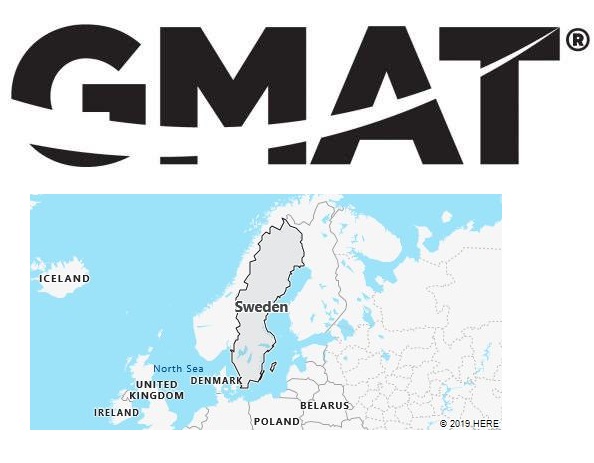GMAT Testing Locations
We have found 2 GMAT test centres in Sweden, located in Gothenburg and Stockholm. For specific test dates of 2019, please refer to the end of this page.

#1. Pearson VUE Test Centre Select – Uni of Gothenburg
University of Gothenburg
Drakegatan 5
412 50 Gothenburg
Sweden
Phone: +46 31 786 5202
Test Center Information
The test center is located at Drakegatan 5 in Gothenburg. You can easily reach it by tram or bus to Ullevi Norra or Ullevi Södra and from there it´s a short walk. There are also plenty of parking lots outside and around the building.
To find more specific directions you can use following links:
https://maps.google.se/maps?q=drakegatan+7&ie=UTF-8&hq=&hnear=0x464ff3821746d5e9:0x479a109cc0919467,Drakegatan+7,+412+50+G%C3%B6teborg&gl=se&ei=xy7yUuLHA8OwywOLz4CoDA&ved=0CCgQ8gEwAA
http://www.vasttrafik.se/#!/en/
PLEASE NOTE: You need to arrive to the test center no later than 30-45 minutes before your scheduled appointment.
#2. Lexicon IT-Proffs
Årstaängsvägen 9, Liljeholmen
117 43 Stockholm
Sweden
Phone: +46 8 511 611 00
Test Center Information
Vägbeskrivning till testcenter hos Lexicon, Liljeholmen Stockholm.
Allmän info gällande Stockholms Lokaltrafik (SL):
Du kan inte köpa biljetter på bussar med kontanter. Skaffa eller fyll på reskassa hos Pressbyrån eller SL Center. Alternativt köp biljett i en automat som finns på vissa busshållplatser eller via din mobil via SMS eller via appen SL. Mer instruktioner finns här: http://www.SL.se.
Använd sökfunktionen och skriv: Beställa SMS-biljett
Åk den röda tunnelbana till Liljeholmen.
Gå mot uppgång tvärbanan/torget.
Gå därefter ut mot tvärbanan, håll dig till höger och gå längst med spåret.
Därefter gå över övergångstället och tvärbanans spår mot Liljeholmskajen och Årstaängsvägen. Du kommer gå under en viadukt. Längre fram ser du Pressbyrån.
Gå till vänster på Årstaängsvägen, till nummer 9.
Nu är du framme vid Lexicon entre, Årstaängsvägen 9. Åk hissen till plan 6.
Testcentret öppnar klockan 08:30.
GMAT Exam Dates in Sweden
Unlike some paper based exams, the GMAT is computer based. Therefore, there are no fixed test dates for GMAT. Wherever you are in Sweden, all test centers are open from Monday through Saturday throughout the year. Some even offer the exam every day of the year. However, some test centers are not open on Sundays and national holidays. For example, most college-based test centers might be closed for extended periods around holidays. For precise testing dates in Sweden, please visit test-maker website – https://www.mba.com/.
More about Sweden
Sweden is located in the east of the Scandinavian Peninsula (Scandinavia), over which the border to Norway (1619 km) runs. To the northeast, the rivers Muonioälv and Torneälv form the border with Finland (586 km). In the east Sweden borders on the Baltic Sea, in the southwest on the Öresund, Kattegat and Skagerrak. A north-south extension of 1,574 km is offset by a maximum width of 499 km. The west coast north of Gothenburg and the east coast north of Kalmar are preceded by numerous archipelagos (the archipelago is a UNESCO World Heritage Site).
In the Baltic Sea are the large islands of Gotland (2,994 km 2) and Öland (1 347 km 2). The (still common) historical tripartite division into Götaland, Svealand, Norrland (from south to north) does not entirely coincide with the geographical breakdown in south, central and north Sweden.
Sweden contributes to the sloping of the Skanden (Kebnekaise 2 111 m above sea level, Sarek 2 090 m above sea level).
The Scandi fall to the east, where their ancient Paleozoic rock masses, interspersed with numerous intrusions, were pushed in the form of scales onto the base of the Baltic Shield, often several hundred meters high; from there, the land is covered in smaller steps (Piedmont stairs) to the southeast against the Baltic Sea. Valuable ore deposits are embedded in the Precambrian, heavily metamorphosed rock masses of the Baltic Shield (gneisses, granites, phyllites, amphibolites, sparagmites). Remnants of sediments from the Cambrian, Ordovician and Silurian times have been preserved in tectonic depressions (Central Swedish Depression, Jämtland) and build the islands of Öland and Gotland on.
The southern Swedish hill country (southern Scania) is built up of Mesozoic sediments (with layers of chalk and small coal deposits) overlaid by Pleistocene moraines.
In the Pleistocene, all of Sweden was covered in ice. Spacious ground moraine areas formed; During the standstill phase of the finiglacial, the central Swedish terminal moraine was deposited, which continues in Finland’s Salpausselkä. In the early post-glacial period, the sea penetrated large parts of Sweden. Fertile marine clays were deposited in the central Swedish depression. The sea arms (Fjärd), reaching far into the land, were formed. The most important postglacial moment in the relief design is the land elevation (today on the coast of Norrbotten still 9 mm annually). – The largest lakes are in the Central Swedish Depression: Vänersee (5 490 km 2), Vättersee (1898 km 2), Malaren (1084 km 2), Hjälmaren (484 km 2).
